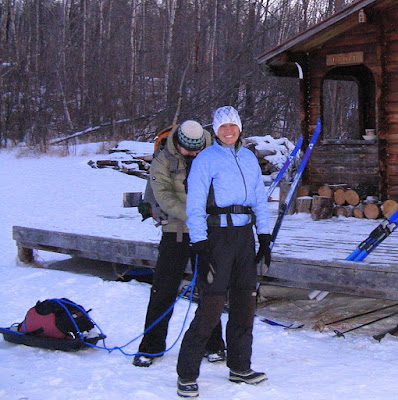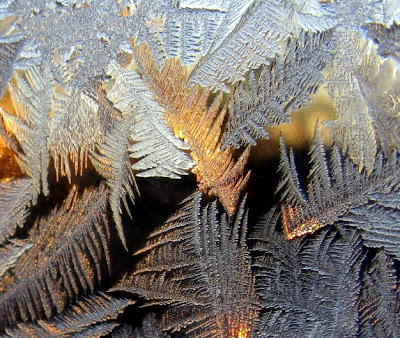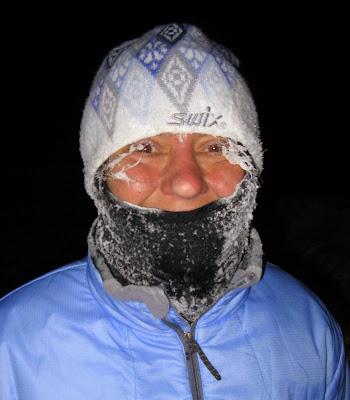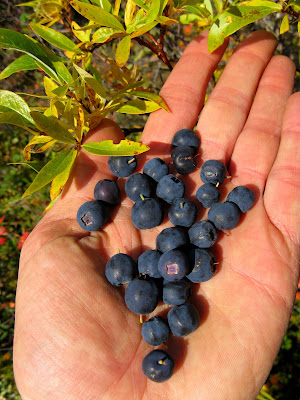Sunrise: 11:28 AM, Sunset: 3:13 PM, Total Sunlight: 3hrs 45min The tarp-lined pool at Horner Hot Springs is a winter oasis.
The tarp-lined pool at Horner Hot Springs is a winter oasis.
We boarded the small fixed-wing aircraft fully draped in our ski clothes and boots on a flight headed about 250 miles west of Fairbanks. Dan and I were traveling out to the remote village of Ruby on the banks of the Yukon River. As with most Alaskan villages, Ruby can only be reached by plane or by a lengthy trip down the Yukon River via boat, snowmachine, dogsled, or skis. Our plan was to arrive in Ruby, strap on our skis right on the airport tarmac, and then travel up-river to spend winter solstice soaking in the warm waters which percolate to the surface at the oasis known as Horner Hot Springs.
 Dan skis from the airport down into Ruby. Gold was discovered near Ruby in the early 1900's but the settlement was officially founded in 1912 and at it's peak had a population close to 3000. Red garnets in the area were confused as "rubies" and the town was mistakenly named. Ruby has remained a native village since the gold rush ended.
Dan skis from the airport down into Ruby. Gold was discovered near Ruby in the early 1900's but the settlement was officially founded in 1912 and at it's peak had a population close to 3000. Red garnets in the area were confused as "rubies" and the town was mistakenly named. Ruby has remained a native village since the gold rush ended. We worked for food during our ski to Horner Hot Springs. Sam and Tamara are building the remote Yukon River Lodge about 15 miles upriver from Ruby. We were treated like kings in their "under construction" but warm home during our trip to/from the springs. These super friendly folks hope to have it open for year-round business sometime the next year or so--please visit them!
We worked for food during our ski to Horner Hot Springs. Sam and Tamara are building the remote Yukon River Lodge about 15 miles upriver from Ruby. We were treated like kings in their "under construction" but warm home during our trip to/from the springs. These super friendly folks hope to have it open for year-round business sometime the next year or so--please visit them! We encountered a mixture of conditions while skiing up the Yukon River. Large sections of the channel were impassable due to vertical knife-like blades of jumbled ice which formed during freeze-up. There was a nice snowmachine trail for a portion of the trip but strong winds in this area result in deep drifts, wind scoured glare ice, and slab crust which would frequently collapse from our weight. There were also a few stretches of overflow water hiding silently under the snowpack which would wet our boots and lock up our ski bindings.
We encountered a mixture of conditions while skiing up the Yukon River. Large sections of the channel were impassable due to vertical knife-like blades of jumbled ice which formed during freeze-up. There was a nice snowmachine trail for a portion of the trip but strong winds in this area result in deep drifts, wind scoured glare ice, and slab crust which would frequently collapse from our weight. There were also a few stretches of overflow water hiding silently under the snowpack which would wet our boots and lock up our ski bindings. Horner Hot Springs is situated about a mile from the Yukon River on the south flanks of the mountains known as the Kokrines in the background. We broke trail through thigh deep snow to get up to the springs.
Horner Hot Springs is situated about a mile from the Yukon River on the south flanks of the mountains known as the Kokrines in the background. We broke trail through thigh deep snow to get up to the springs. The hot water in this area seeps from the surrounding hillside. A small collection pond dug into the embankment above provides water to a pipe which feeds the springs below. The temperature was a comfortable 103F(39C)degrees. There wasn't much flat real estate adjacent to the springs but we were able to find just enough space to set up our tent.
The hot water in this area seeps from the surrounding hillside. A small collection pond dug into the embankment above provides water to a pipe which feeds the springs below. The temperature was a comfortable 103F(39C)degrees. There wasn't much flat real estate adjacent to the springs but we were able to find just enough space to set up our tent. Dan crashes at the luxury accommodations at the Ruby airport while we wait for our plane back to Fairbanks. Fortunately for us it was a warm +10F (-12C)...
Dan crashes at the luxury accommodations at the Ruby airport while we wait for our plane back to Fairbanks. Fortunately for us it was a warm +10F (-12C)...
Here is a link to an old photograph of Horner Hot Springs: old photo. A pipe carrying hot water from the hillside is visible behind the cabin. Notice how the the faint caption appropriately says, "A sure cure for grouch, rheumatism, and the blues." The remains of this log structure appear to have completely dissolved into the soil of the surrounding boreal forest.
Here is also a link to some fascinating historical shots from the Ruby area when it was a bustling goldrush town: Ruby in the past.
Sunday, December 21, 2008
Winter Solstice at Horner Hot Springs
Posted by
Ed Plumb
at
11:06 PM
1 comments
![]()
Labels: Remote Alaska Hot Springs, Ski Traverse
Sunday, December 7, 2008
Mad props to Dea

The howling wind swirls millions of snowflakes around the tiny cabin. Occasional gusts make our warm refuge shudder vigorously as we anticipate fragments of the structure beginning to peel away with each successive blow. The cold and driving snow surreptitiously creep into our warm sanctuary through any available gap. This was another epic trip for some of our group out to the springs about a 100-miles north of Fairbanks.
I was accompanied by my friend Dea on this recent excursion. Dea is still patiently waiting for a kidney transplant. In the meantime she is into her third year of linking herself up to a dialysis machine which acts as a surrogate kidney that removes waste products from her blood and excess fluid from her body. If she misses even one of her tri-weekly treatments she would not be here with us today.
Dea's motivation to rise each morning and live a normal lifestyle under the difficult circumstances she is challenged with everyday is unequal to anything I can possibly imagine. She is out experiencing a life that is unfathomable to other dialysis patients. This past weekend...her passion for adventure gave her the endurance to plow through shoulder high drifts, post hole for hours through crotch deep snow, and brace herself against howling winds and subzero wind chills. Its difficult for me to express in a series of words the admiration I have for this very special person in my life.



Posted by
Ed Plumb
at
11:47 PM
8
comments
![]()
Labels: Remote Alaska Hot Springs
Sunday, November 9, 2008
Borealis times two
 The aurora borealis dances above the Borealis cabin in the White Mtns
The aurora borealis dances above the Borealis cabin in the White Mtns
Silence.... I am always surprised how the complete lack of sound can be so loud. It doesn't quite make sense when I rationally contemplate the physics of it. A winters night in a cold and windless valley in Alaska radiates a silence so powerful that it is difficult to describe. A silence that makes you stand completely still and struggle to absorb some sort of distance vibration traveling through the atmosphere - a breeze rustle a branch, ice expanding on the river, an owl hooting, a jet flying miles overhead, a lone wolf howling at the moon. In the end the only conscious sound that I hear is that of the blood being pumped within my body and pulsing through my arteries and veins.
I was just reminded of the deafening sound of silence during a jaunt with Ann out into the White Mountains north of Fairbanks. Ann and I ventured 20 miles out to the Borealis cabin on the frozen shores Beaver Cr over the weekend. We were last here in May shivering in the early morning sunshine as we stumbled out of our packrafts during an overnight traverse in the endless twilight. Ann frosted over as she radiates heat into the -20F(-30C) arctic air.
Ann frosted over as she radiates heat into the -20F(-30C) arctic air. The entire forest was cloaked with a bouquet of hoar frost crystals that shimmered in the mid-day sunshine.
The entire forest was cloaked with a bouquet of hoar frost crystals that shimmered in the mid-day sunshine. Two inch long crystals were delicately clinging to everything exposed to the atmosphere.
Two inch long crystals were delicately clinging to everything exposed to the atmosphere. Slapping more kick-wax on my skis - grasses and sticks protruding through the snowpack quickly peeled the wax from my ski base. The low lying boggy areas still need some more snow before the tussocks are entirely covered and the trenches in between are completely filled in.
Slapping more kick-wax on my skis - grasses and sticks protruding through the snowpack quickly peeled the wax from my ski base. The low lying boggy areas still need some more snow before the tussocks are entirely covered and the trenches in between are completely filled in. Peering out of the cabin before we ski back to civilization.
Peering out of the cabin before we ski back to civilization. The high noon sun gradually drops closer and closer to the horizon as we head toward winter solstice and a few meager hours of sunshine each day.
The high noon sun gradually drops closer and closer to the horizon as we head toward winter solstice and a few meager hours of sunshine each day.
Posted by
Ed Plumb
at
7:16 PM
3
comments
![]()
Monday, November 3, 2008
Back into the Whites
 Dan studies a trail junction sign in the White Mtns
Dan studies a trail junction sign in the White MtnsA whole new world opens up as winter descends upon the north and rivers, lakes, and the swampy lowlands freeze-up. Areas that were nearly impassable in the summer months are easily accessed as a blanket of snow accumulates on the landscape. This means that a whole network of winter-only trail systems come to life as dog mushers, snow machiners and skiers explore the countryside. Dan and I made our maiden voyage of the winter to a cabin on one of these trails up in the White Mountains this weekend.
 Mashed potatoes by candle light in the Moose Creek cabin
Mashed potatoes by candle light in the Moose Creek cabin Curtains of northern lights gracefully move across the sky. The aurora was quite nice when I got up to relieve myself in the middle of the night. I will forever revel in the novelty of seeing at least some auroral activity on most clear nights during the winter months.
Curtains of northern lights gracefully move across the sky. The aurora was quite nice when I got up to relieve myself in the middle of the night. I will forever revel in the novelty of seeing at least some auroral activity on most clear nights during the winter months. Dan and Sky depart the Moose Creek cabin
Dan and Sky depart the Moose Creek cabin
Posted by
Ed Plumb
at
11:32 PM
1 comments
![]()
Sunday, October 26, 2008
Blue October
 An unusual scene for October with vehicles plugged in to keep them warm so they will start. This looks more like a mid-winter scene...not October. It's been unusually chilly in northern Alaska with temperatures well below zero Fahrenheit.
An unusual scene for October with vehicles plugged in to keep them warm so they will start. This looks more like a mid-winter scene...not October. It's been unusually chilly in northern Alaska with temperatures well below zero Fahrenheit.
The white dedritic fingers in the upper half of the image are the deep cold river valleys in the Brooks Range mountains. The dense cold air sinks to the valley bottoms and remains there until some sort of mechanism kicks it out (warm air, clouds, etc). There are few, if any, ground based observation sites in this area but this satellite image suggests that the coldest (blue pixels) valleys are approaching -50F (-46C) ---> and its only October! These are by far some of the coldest temperatures being experienced in the northern hemisphere today.
Posted by
Ed Plumb
at
10:31 PM
1 comments
![]()
Labels: Cold Weather
Wednesday, October 15, 2008
Scenes from Central Asia
 Mir-i-Arb Medressa (active Islamic school) in Bukhara, Uzbekistan
Mir-i-Arb Medressa (active Islamic school) in Bukhara, Uzbekistan
I just returned from nearly 5 weeks of stumbling my way across the Central Asian republics of Kyrgyzstan and Uzbekistan. The abundance of scenery, ancient architecture, historical sites, and culturally diverse people along the ancient Silk Route through the heart of Asia was absolutely fascinating. I found it difficult to absorb or retain even a fraction of the history of this region which has been invaded from various directions for centuries. Irregardless of my ability to grasp the history of this area, it was a memorable trip through a very welcoming and friendly part of the world. Here is a map of the former Soviet Republics that define central Asia
Here is a map of the former Soviet Republics that define central Asia
Here are some pictures from my trip: Scenes from Central Asia
Posted by
Ed Plumb
at
11:54 PM
0
comments
![]()
Wednesday, September 17, 2008
Бишкек, Кыргызстан
 A exhibition of aerial photos on display in the Kyrgyz capital
A exhibition of aerial photos on display in the Kyrgyz capital
Бишкек, Кыргызстан (aka: Bishkek, Kyrgyzstan ) - the capital of this relatively small and mountainous central Asian country. I am here living with a Kyrgyz family and brushing up on my Russian at a language immersion school before continuing my travels through some of the former Soviet central Asian Republics.
Bishkek seems relatively uninteresting on the surface and has the feel of other post-Soviet cities I have visited with concrete block apartment monstrosities, dilapidated sidewalks, numerous kiosks on every corner selling anything from notebooks, cell phones, fresh veggies, booze, cigarettes, fresh bread, to gold watches. But just in my short time here I can sense that there is more to this city than whats readily visible at first glance. Some of the members of my host family in Bishkek. During the summer, they cook, eat, and socialize outside in their small courtyard.
Some of the members of my host family in Bishkek. During the summer, they cook, eat, and socialize outside in their small courtyard. Changing of guards in front of the State Historical Museum
Changing of guards in front of the State Historical Museum Traditional ak kalpak's (Kyrgyz white felt hat) are still quite fashionable and can occasionally be seen even in the urban capital.
Traditional ak kalpak's (Kyrgyz white felt hat) are still quite fashionable and can occasionally be seen even in the urban capital. Girls of Bishkek play on the canons in the park. The rainbow girls outfit is outrageously circa early 80's.
Girls of Bishkek play on the canons in the park. The rainbow girls outfit is outrageously circa early 80's. My host brother Tynchtyk (which translates as "Peace" in Kyrgyz) changes the brakes of his families marshutka. A marshutka is sort of a cross between a taxi and a city bus with set routes. This mode of transportation is notoriously known to be one of the most uncomfortable rides as people cram in as tight as sardines in a can. Its an experience that I would avoid whenever possible.
My host brother Tynchtyk (which translates as "Peace" in Kyrgyz) changes the brakes of his families marshutka. A marshutka is sort of a cross between a taxi and a city bus with set routes. This mode of transportation is notoriously known to be one of the most uncomfortable rides as people cram in as tight as sardines in a can. Its an experience that I would avoid whenever possible.
Posted by
Ed Plumb
at
5:58 AM
1 comments
![]()
Saturday, September 13, 2008
East Meets West
 One of the many mosques which define the Istanbul skyline
One of the many mosques which define the Istanbul skyline
Istanbul - what a fascinating mix of cultures in this metropolis of 14 million or so that bridges Europe to the west and Asia to the east. This is quite an amazing city that is difficult to describe in only a few words. From the haunting sounds of the pre-dawn call to prayer echoing through the streets each morning from the uncountable mosques scattered about the city...to the myriad of boats criss-crossing the Strait of Bosphorus...to the hordes of people moving fluidly through the narrow alleys. Istanbul is a mishmash of eastern and western cultures. Vendors sell a variety of items in the Istanbul spice market.
Vendors sell a variety of items in the Istanbul spice market. I am not quite sure what this is composed of or if it really works.
I am not quite sure what this is composed of or if it really works. Topkapi Palace - giant vats which were used to prepare feasts for the sultans.
Topkapi Palace - giant vats which were used to prepare feasts for the sultans. A window in Aya Sofia frames the Blue Mosque
A window in Aya Sofia frames the Blue Mosque Morning sunlight illuminates the ceramic tiled ceiling of the Blue Mosque
Morning sunlight illuminates the ceramic tiled ceiling of the Blue Mosque The 6th century Basilica Cistern underlies a portion of Istanbul. This giant subterranean structure was first built to provide water to the great palace of Constantinople and other surrounding buildings.
The 6th century Basilica Cistern underlies a portion of Istanbul. This giant subterranean structure was first built to provide water to the great palace of Constantinople and other surrounding buildings. A busy harbor on the Strait of Bosphorus.
A busy harbor on the Strait of Bosphorus.
Posted by
Ed Plumb
at
5:46 PM
4
comments
![]()
Tuesday, September 9, 2008
German Invasion

So they drove the Beetle to San Francisco, picked up another German, and flew back up to Fairbanks. The only catch is - the van doesn't run. So they befriended my neighbor down the road who has a nice workshop and will use this space to frantically make the vehicle operational before the snow arrives in the next few weeks. Then they will hit the road and drive it down to San Francisco. I am not quite sure what to say about this craziness...except that they are German and this seems to explain a few things.
Posted by
Ed Plumb
at
10:21 PM
1 comments
![]()
Monday, September 1, 2008
McClaren Summit to Eureka Creek Traverse

I headed south to the Alaska Range with Lisa and Andy over the Labor Day weekend. I had heard that from and old college friend that this was a superb packrafting route (thanks Jeff). The fall colors were just about peaking and the wildlife was abundant. We saw numerous groups of caribou grazing on lichens in the open expanse of tundra. This was quite an unusual traverse in that there was very little bushwhacking and a surprising lack of wet, soggy, tussock infested tundra.
















Posted by
Ed Plumb
at
10:47 PM
7
comments
![]()
Labels: Packrafting

